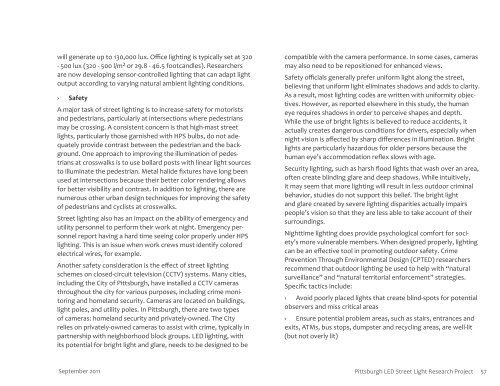LED Street Light Research Project
LED Street Light Research Project
LED Street Light Research Project
Create successful ePaper yourself
Turn your PDF publications into a flip-book with our unique Google optimized e-Paper software.
will generate up to 130,000 lux. Office lighting is typically set at 320<br />
- 500 lux (320 - 500 l/m 2 or 29.8 - 46.5 footcandles). <strong>Research</strong>ers<br />
are now developing sensor-controlled lighting that can adapt light<br />
output according to varying natural ambient lighting conditions.<br />
› Safety<br />
A major task of street lighting is to increase safety for motorists<br />
and pedestrians, particularly at intersections where pedestrians<br />
may be crossing. A consistent concern is that high-mast street<br />
lights, particularly those garnished with HPS bulbs, do not adequately<br />
provide contrast between the pedestrian and the background.<br />
One approach to improving the illumination of pedestrians<br />
at crosswalks is to use bollard posts with linear light sources<br />
to illuminate the pedestrian. Metal halide fixtures have long been<br />
used at intersections because their better color rendering allows<br />
for better visibility and contrast. In addition to lighting, there are<br />
numerous other urban design techniques for improving the safety<br />
of pedestrians and cyclists at crosswalks.<br />
<strong>Street</strong> lighting also has an impact on the ability of emergency and<br />
utility personnel to perform their work at night. Emergency personnel<br />
report having a hard time seeing color properly under HPS<br />
lighting. This is an issue when work crews must identify colored<br />
electrical wires, for example.<br />
Another safety consideration is the effect of street lighting<br />
schemes on closed-circuit television (CCTV) systems. Many cities,<br />
including the City of Pittsburgh, have installed a CCTV cameras<br />
throughout the city for various purposes, including crime monitoring<br />
and homeland security. Cameras are located on buildings,<br />
light poles, and utility poles. In Pittsburgh, there are two types<br />
of cameras: homeland security and privately-owned. The City<br />
relies on privately-owned cameras to assist with crime, typically in<br />
partnership with neighborhood block groups. <strong>LED</strong> lighting, with<br />
its potential for bright light and glare, needs to be designed to be<br />
September 2011<br />
compatible with the camera performance. In some cases, cameras<br />
may also need to be repositioned for enhanced views.<br />
Safety officials generally prefer uniform light along the street,<br />
believing that uniform light eliminates shadows and adds to clarity.<br />
As a result, most lighting codes are written with uniformity objectives.<br />
However, as reported elsewhere in this study, the human<br />
eye requires shadows in order to perceive shapes and depth.<br />
While the use of bright lights is believed to reduce accidents, it<br />
actually creates dangerous conditions for drivers, especially when<br />
night vision is affected by sharp differences in illumination. Bright<br />
lights are particularly hazardous for older persons because the<br />
human eye’s accommodation reflex slows with age.<br />
Security lighting, such as harsh flood lights that wash over an area,<br />
often create blinding glare and deep shadows. While intuitively,<br />
it may seem that more lighting will result in less outdoor criminal<br />
behavior, studies do not support this belief. The bright light<br />
and glare created by severe lighting disparities actually impairs<br />
people’s vision so that they are less able to take account of their<br />
surroundings.<br />
Nighttime lighting does provide psychological comfort for society’s<br />
more vulnerable members. When designed properly, lighting<br />
can be an effective tool in promoting outdoor safety. Crime<br />
Prevention Through Environmental Design (CPTED) researchers<br />
recommend that outdoor lighting be used to help with “natural<br />
surveillance” and “natural territorial enforcement” strategies.<br />
Specific tactics include:<br />
› Avoid poorly placed lights that create blind-spots for potential<br />
observers and miss critical areas<br />
› Ensure potential problem areas, such as stairs, entrances and<br />
exits, ATMs, bus stops, dumpster and recycling areas, are well-lit<br />
(but not overly lit)<br />
Pittsburgh <strong>LED</strong> <strong>Street</strong> <strong>Light</strong> <strong>Research</strong> <strong>Project</strong> 57


